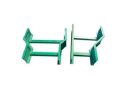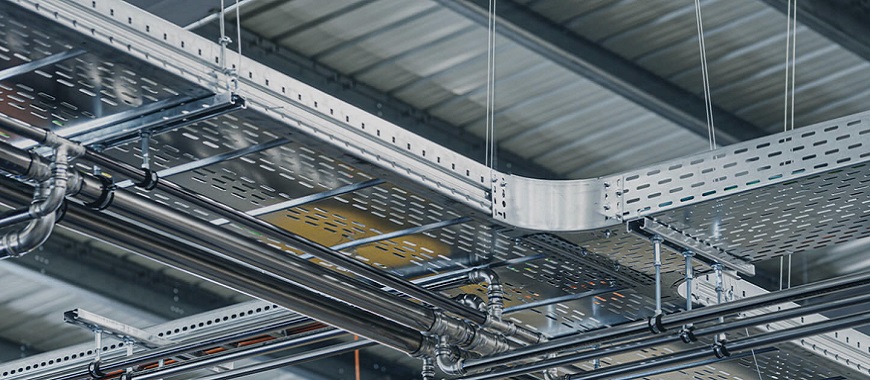
NEC cable tray fill requirements specify a 50% max fill ratio, with TIA recommending 40% for optimal cable management. Cable tray systems play a critical role in organizing and managing electrical cables in both industrial and commercial settings. These systems allow for efficient cable routing, reducing clutter and minimizing the risk of damage to cables. The proper cable tray use ensures that cables are safely supported and protected, preventing unnecessary wear. Adhering to the NEC cable tray fill requirements and correct pathways sizing is crucial for ensuring safety and optimal system performance. The National Electrical Code (NEC) provides specific guidelines on how much of a cable tray should be filled, accounting for factors such as cable type, tray size, and heat dissipation needs. This article will help readers understand the NEC cable tray fill requirements, offering guidance on calculations and proper sizing to ensure compliance with these standards. By following these requirements, professionals can prevent common installation issues and ensure safe, efficient cable management.
NEC Cable Tray Fill Requirements: What is Cable Tray Fill and Why Does It Matter?
Cable Tray Fill: Importance and Compliance
Cable tray fill refers to the percentage of a cable tray’s total volume that is occupied by cables. Maintaining the appropriate fill level in cable tray runs is essential for ensuring safety, optimal performance, and compliance with industry standards like the NEC cable tray fill requirements. Correctly filling a cable tray helps prevent several potential issues, including overheating, electromagnetic interference (EMI), and system failures. Conversely, improperly filling the tray—either overfilling or underfilling—can have negative consequences, ranging from safety hazards to inefficient resource usage.
Importance of Correct Cable Tray Fill
Safety and Fire Prevention
When cables are packed too tightly, heat generated by electrical current cannot dissipate efficiently, leading to overheating. Overheated cables risk insulation damage, increasing the likelihood of electrical fires or short circuits. Correct cable tray fill is crucial for cable tray safety, as it ensures sufficient air circulation and cooling, helping to maintain safe operating temperatures. Properly managing cable tray fill not only prevents overheating but also minimizes the risk of fire hazards, contributing to a safer working environment.
Optimizing Performance
Cables that are properly spaced benefit from improved signal integrity and reduced interference. By preventing cables from being bundled too tightly, the risk of electromagnetic interference (EMI) is minimized, ensuring the performance and reliability of electrical and communication systems, particularly where sensitive data cables are involved.
Future Expansion
Proper cable tray design with the correct fill percentage not only improves current system performance but also allows for easier future expansion. It provides flexibility for adding new cables without major modifications to the system, reducing downtime and ensuring that additional cables can be accommodated without compromising the system’s integrity.
Balancing Cable Tray Fill for Safety and Efficiency
Balancing the fill percentage of a cable tray involves making sure that the tray is neither overfilled nor underfilled. The NEC sets clear guidelines for the maximum allowable fill percentage for different types of cables and tray configurations. Adhering to these requirements helps installers achieve an ideal balance between safety, airflow, and system capacity.
Proper Air Circulation
Maintaining adequate space between cables ensures that air can circulate freely around the cables. This is critical for heat dissipation, especially in high-current systems. Proper ventilation reduces the risk of overheating, which can lead to cable damage, increased wear, or electrical failure.
Preventing Overcrowding
Overfilling the tray with cables can obstruct airflow and lead to excessive bundling. This increases the chances of EMI, which can disrupt nearby communication systems or cause power issues. By following NEC guidelines and leaving sufficient space in the tray, cables can function at optimal efficiency without interference or overheating.
Space for Future Cables
When designing cable trays, it’s important to consider not just current requirements but also future needs. Maintaining a reasonable fill percentage allows for easy addition of new cables as infrastructure grows, without the need for reworking or expanding the system.
The Consequences of Incorrect Cable Tray Fill
Improper cable tray fill—whether overfilling or underfilling—can lead to several problems that affect system performance, safety, and long-term functionality.
Overfilling the Tray
- Overheating: When a tray is overfilled, there is insufficient space for air circulation. This results in heat buildup, which can cause cable insulation to deteriorate and increase the risk of fire or electrical failure.
- Increased EMI: Bundling cables too closely together increases the chances of electromagnetic interference (EMI). This can impact the performance of sensitive equipment like computers, data servers, and telecommunications systems.
- Cable Damage: Overcrowded trays can lead to physical damage to the cables, including abrasion from friction or crushing from excessive weight.
Underfilling the Tray:
- Wasted Space: While underfilling a tray may not present immediate safety risks, it leads to inefficient use of resources. The extra space in the tray is wasted, resulting in higher installation costs as additional trays or supports may be needed to accommodate future cables.
- Higher Costs: Overestimating the need for space or not considering future expansions can result in the need for additional materials or reworking of the installation to accommodate future cables, increasing overall project costs.
- Less Optimized System: An underfilled tray may not optimize the available space for maximum cable density and could lead to inefficiencies, especially in commercial or industrial installations where space and cost efficiency are crucial.
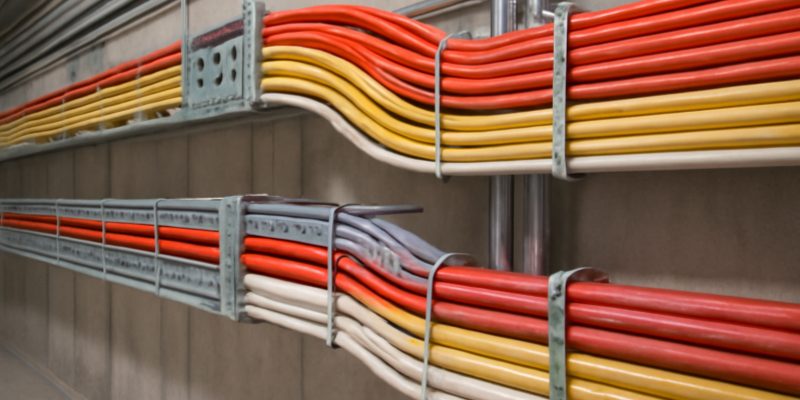
Low Profile Door Carpet Cable Tray for Seamless Integration
NEC Cable Tray Fill Requirements Explained
The NEC cable tray fill requirements are designed to ensure that cables within a tray are properly organized and spaced to avoid safety issues. Under NEC 392, there are specific regulations for how cables should be arranged in tray systems. For example, the maximum fill ratio depends on the cable type and tray dimensions. This helps prevent congestion and allows for sufficient airflow around the cables, reducing the risk of overheating and ensuring that cables function optimally.
Cable Tray Fill Chart and Calculations
The NEC cable tray fill chart provides guidelines for how much of the tray’s cross-sectional area can be filled based on the size of the cables used. This chart is particularly helpful when calculating the maximum cable fill for different cable types, such as power or control cables. By referring to the fill chart, engineers can determine how many cables can be safely routed in the tray without exceeding the recommended fill limits.
Cable tray fill calculation involves determining the space taken up by the cables and comparing it to the tray’s capacity. It’s important to consider both the individual cable sizes and the total volume of cables in the tray. Following the NEC cable tray fill capacity ensures safe installations, reduces the risk of overheating, and supports the longevity and efficiency of the system.
Importance of Proper Cable Spacing
Proper cable spacing within the tray is not only essential for compliance with the NEC but also helps reduce the risk of electromagnetic interference (EMI) and enhances the longevity of the system. Adequate spacing allows for better airflow, enabling heat dissipation and preventing cables from becoming damaged due to excessive heat build-up. Following these guidelines ensures that the cable tray system operates efficiently and safely over its lifespan.
NEC Cable Tray Fill Requirements: How to Calculate Cable Tray Fill
Calculating the proper cable tray fill is crucial for complying with the NEC cable tray fill requirements and ensuring the safety and performance of your system. Proper tray fill ensures that cables can operate efficiently without overheating, and it helps maintain airflow within the system. This step-by-step guide will walk you through the process to calculate the correct cable tray fill.
Step 1: Determine the Number of Conductors
The first step in calculating the cable tray fill is determining the number of conductors you plan to install in the tray. This includes all cables, both power and control cables. For accurate calculations, make sure to count each conductor separately, as the space required for each may differ depending on the type and size of the cable. Keep in mind that the types of cables used in the tray may have different fill requirements, so it is important to account for each one accordingly.
Step 2: Calculate the Cross-Sectional Area of the Cables
Next, you’ll need to calculate the cross-sectional area of each cable. This can be done by referring to the specifications provided by the manufacturer of each type of cable. Typically, these specifications will include the outer diameter of the cable. You can use this diameter to calculate the area, using the formula for the area of a circle:
A=π×(r2)A = \pi \times (r^2)A=π×(r2)
Where rrr is the radius (half of the diameter). If the cables have different shapes or insulation types, you may need to adjust this formula to account for these variations.
Step 3: Determine the Tray’s Cross-Sectional Area
Once you have the area of the cables, you need to calculate the tray’s cross-sectional area. The tray’s area is typically calculated by multiplying its width by its depth. This is a straightforward calculation, but it is important to ensure that the tray is being measured correctly. Different tray types (such as ladder, trough, or solid bottom trays) may have different shapes, so the method of calculating the cross-sectional area can vary slightly depending on the design.
Step 4: Compare the Total Cross-Sectional Area of Cables to the Tray’s Area
Finally, compare the total cross-sectional area of all the cables to the tray’s available cross-sectional area. The total area of the cables should never exceed the specified fill ratio, as determined by the NEC cable tray fill requirements. The NEC generally recommends a maximum fill ratio of 50%, although other standards or guidelines (such as those from the TIA) may recommend a lower fill ratio, such as 40%.
By making sure the total cross-sectional area of your cables does not exceed the allowable fill ratio, you can ensure that your installation complies with the NEC guidelines. This step also allows sufficient room for air circulation, preventing overheating and ensuring the long-term reliability and safety of your electrical system.
Additional Considerations
- Cable Types: Different types of cables, such as power cables and control cables, may have different fill ratios. Always check the specifications and the NEC guidelines for the specific cables you are using.
- Tray Design: The design of the cable tray may affect the calculation of the fill ratio. Be sure to take the shape and configuration of the tray into account, as some tray types may allow for more efficient use of space.
- Environmental Factors: Consider the installation environment, as factors like ambient temperature and air circulation can influence the amount of fill that is acceptable. If the installation is in a warmer environment, you may need to reduce the fill ratio to allow for better cooling.
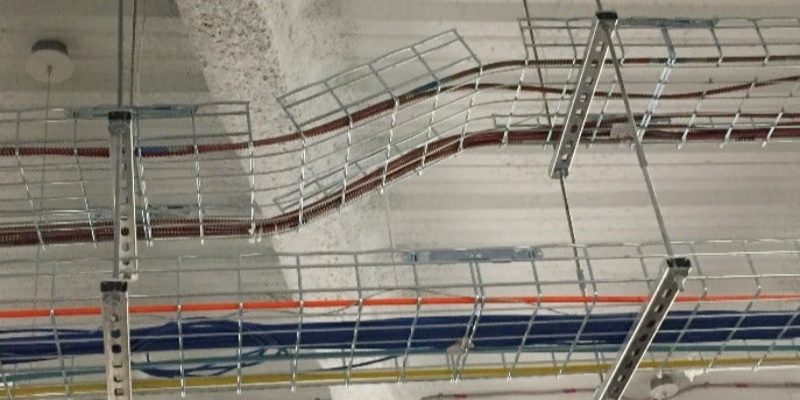
Medium Voltage Cable Tray Installation: Comprehensive Guide
NEC 392 Cable Tray Fill Guidelines and Standards
The NEC 392 cable tray fill requirements outline the maximum allowable fill and ensure that the cable tray functions safely and efficiently. These regulations are based on factors such as the tray size, cable type, and environmental conditions. As the cable tray market continues to grow, it is important to stay updated on these standards to ensure compliance with industry norms. NEC 392 specifies that a maximum of 50% of the tray’s cross-sectional area can be filled with control cables, while power cables can occupy up to 40% of the tray’s area. These limits are in place to maintain adequate space for air circulation, which helps in the heat dissipation process. The NEC cable tray fill requirements also take into account the differences in cable construction, ensuring that cables with larger diameters or multiple layers are accounted for in the fill calculations. To comply with these standards, it is critical to leave adequate space between cables, allowing for efficient airflow and reducing the risk of cable overheating or damage.
Tray Size and Cable Type Considerations
NEC 392 sets different fill limits for control and power cables. Control cables can fill up to 50% of the tray’s cross-sectional area, while power cables are restricted to 40%. These limits ensure sufficient airflow for heat dissipation, preventing overheating and cable damage. Power cables, being larger, require more space due to their insulation, while control cables are smaller and more flexible, allowing them to occupy more space in the tray. Proper pathways sizing is crucial to accommodate the varying cable types, ensuring the tray is not overfilled and that air circulation is optimized for both cable types.
Environmental Conditions and Heat Dissipation
Environmental conditions, such as temperature, play a key role in determining cable tray fill limits. In hotter environments, you may need to reduce the fill ratio to allow better cooling and airflow. Adequate space between cables enables heat dissipation, maintaining safe operating conditions. Without sufficient space, cables can overheat, leading to insulation damage and increased risk of failure. Properly calculating fill ratios helps mitigate environmental challenges and ensure safe performance of the electrical system.
Cable Construction and Fill Calculations
Different cable constructions, such as larger diameters or multiple layers of insulation, affect tray fill calculations. High-voltage cables, for example, require more space due to thicker insulation. The NEC 392 guidelines take these factors into account, ensuring cables with larger cross-sections are properly accommodated. Accurate calculations of cable size and insulation layers are necessary to avoid exceeding the tray’s fill capacity, preventing overcrowding and maintaining safe, efficient system operation.
Maintaining Adequate Space Between Cables
To ensure proper heat dissipation, adequate space must be maintained between cables in the tray. This spacing allows airflow around each cable, preventing overheating. Crowding cables together restricts airflow, increasing the risk of heat buildup and potential cable damage. Properly planned cable arrangements maximize the available space, ensuring that cables are not tightly packed. Following the NEC 392 guidelines helps optimize cable tray systems, promoting long-term reliability and safety.
Compliance and Industry Norms
Adhering to NEC 392 cable tray fill guidelines is essential for ensuring both safety and compliance with industry standards. With the growing use of cable trays, it’s important for professionals to stay updated on evolving standards. Non-compliance can lead to risks such as overheating, equipment failure, and costly repairs. Regularly checking the latest NEC guidelines ensures electrical systems are safe, efficient, and meet the required fill capacity for maximum performance.
NEC Cable Tray Fill Requirements: Cable Spacing in Cable Trays
Proper cable spacing in cable tray is vital to comply with NEC cable tray fill requirements. Adequate spacing between cables ensures proper airflow, allowing heat to dissipate effectively and preventing overheating. The NEC guidelines specify minimum spacing between cables based on their type and size. For example, when cables are tightly bundled, the risk of overheating increases, which can affect their performance and longevity. Spacing also helps reduce the chance of electromagnetic interference (EMI), which is particularly important in industrial environments where sensitive control systems are used.
Importance of Adhering to NEC Fill Percentage
When designing a cable tray system, it is crucial to adhere to the NEC (National Electrical Code) fill percentage requirements. These guidelines are designed to ensure safe, efficient, and compliant cable management. By maintaining the proper fill percentage, you ensure that there is adequate space between cables, which promotes air circulation, prevents overheating, and reduces the risk of electromagnetic interference (EMI). Proper cable spacing also facilitates easy maintenance and provides room for future upgrades or expansions, allowing additional cables to be installed without compromising the system’s integrity or performance.
Adhering to the NEC fill percentage guidelines helps avoid potential issues that could arise from overcrowded trays, such as insulation damage, system malfunctions, or safety hazards. The correct fill percentage is also essential for ensuring longevity and reliability, as it ensures that cables can perform optimally over the life of the installation.
Preventing Overheating and EMI with Proper Spacing
One of the primary reasons for adhering to the NEC cable tray fill percentage is to prevent overheating and electromagnetic interference (EMI). Both overheating and EMI can lead to significant issues in a cable management system, including damage to cables and equipment failure.
Overheating Risks
Cables generate heat as electrical current passes through them. When cables are placed too closely together, the heat cannot dissipate effectively, leading to heat buildup. Overheating can cause:
- Insulation Breakdown: The heat can degrade the insulation around the cables, potentially leading to short circuits, electric shock, or fires.
- Reduced Cable Lifespan: Excessive heat accelerates the aging of cables, reducing their performance and overall lifespan. Overheating can lead to cable failure or system outages, especially in high-power applications.
By adhering to the proper fill percentage, cables are spaced in such a way that allows for adequate airflow and heat dissipation, ensuring they operate within safe temperature limits. This helps prevent insulation degradation, fire risks, and performance issues.
Electromagnetic Interference (EMI)
When power cables and data cables are bundled too closely together in a tray, electromagnetic interference (EMI) can occur. EMI happens when the magnetic fields created by electrical currents in power cables affect the signals carried by data cables, leading to:
- Data Signal Disruption: High levels of EMI can cause data corruption or signal loss, especially in sensitive systems such as computers, servers, or telecommunications equipment.
- Increased Error Rates: In environments where high-speed data transfer is critical, EMI can increase error rates and reduce the overall efficiency and performance of the system.
By ensuring proper cable spacing according to NEC fill percentage guidelines, the risk of EMI is minimized. This allows data cables to function correctly without interference from adjacent power cables, maintaining signal integrity and improving overall system reliability. In environments where high-power cables and low-voltage data cables are installed in the same tray, maintaining the correct fill percentage is particularly important for reducing the risk of cross-talk and preserving the quality of data transmission.
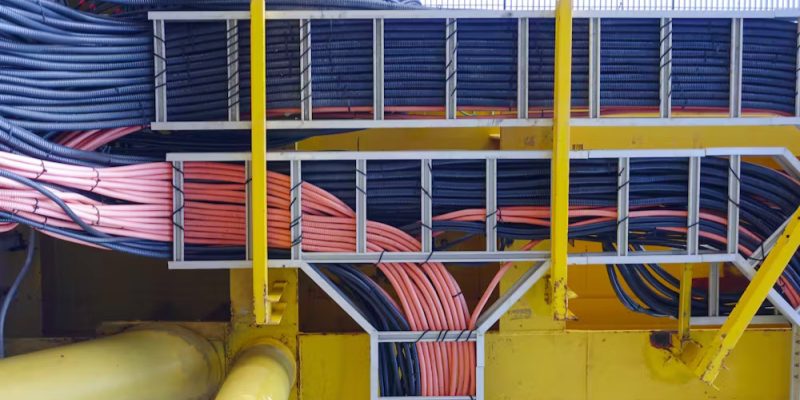
Cable Tray to Conduit Transition: Step-by-Step Guide
Practical Tips for Ensuring Compliance with NEC Cable Tray Fill Requirements
Ensuring compliance with the NEC (National Electrical Code) cable tray fill requirements is crucial for maintaining the safety, efficiency, and longevity of your electrical systems. Following the right procedures during installation helps avoid violations, reduces risk, and optimizes the system’s performance. Below are several practical tips that can help ensure your cable tray setups align with the required standards.
Measure and Calculate Tray Fill Accurately
Accurate tray fill calculation is critical for compliance with NEC cable tray fill requirements. Use tools like cable tray fill charts or NEC fill calculators to determine the correct tray size and cable fit. Proper calculation ensures the tray doesn’t exceed the specified fill ratio, preventing overheating and ensuring optimal cable operation.
Avoid Overfilling the Tray
Overfilling a tray can hinder heat dissipation, leading to potential cable damage. NEC recommends a 50% maximum fill ratio, with TIA suggesting 40% for some installations. By staying within these limits, you ensure proper airflow, reduce risk, and make future cable additions easier without compromising system safety or performance.
Use the Right Tools and Resources
Using the correct tools and resources, like cable tray sizing PDFs and fill charts, is essential to meet NEC cable tray fill requirements. These tools ensure accurate tray selection and prevent overfilling, reducing the chance of installation errors. Refer to up-to-date guidelines and resources for compliance with current NEC standards and safety practices.
Be Mindful of Cable Types
Different cables have varying spacing and fill ratio requirements. For instance, power cables need more space than control cables due to insulation type and heat dissipation needs. Always check manufacturer guidelines for each cable type and adhere to the recommended fill ratios to optimize safety and performance in compliance with NEC standards.
Consider Environmental Factors
Environmental conditions, such as temperature and air circulation, affect cable tray performance. In high-temperature environments, a reduced fill ratio may be necessary to allow better airflow and cooling. Always factor in the installation environment when calculating tray fill ratios to ensure system safety and effective heat management in compliance with NEC guidelines.
Maintain Flexibility for Future Modifications
Plan cable tray installations with future expansions in mind. Leaving extra space allows for additional cables without exceeding NEC fill limits. Flexible designs prevent rework and allow easy upgrades, ensuring continued compliance and efficient operation as your system grows or changes over time.
Regular Inspections and Maintenance
Routine inspections are essential to maintaining compliance with NEC cable tray fill requirements. As cables are added or replaced, the fill ratio may need adjustment. Regular checks for heat buildup, cable wear, and sufficient spacing ensure long-term safety, performance, and compliance with safety regulations.
FAQs about NEC Cable Tray Fill Requirements
The NEC section fill for cable trays refers to the maximum allowable space in a cable tray that can be occupied by cables, as specified by the National Electrical Code (NEC). This ensures that cables are installed in a manner that allows for adequate airflow, which is essential for heat dissipation and preventing overheating. The primary standard for cable tray fill is found under NEC Article 392, which governs cable tray systems. According to these guidelines, the general fill limit is up to 50% of the tray’s cross-sectional area for power cables and up to 40% for communication cables. These limits help maintain the integrity of the cables and reduce the risk of electrical hazards caused by excessive heat buildup. Additionally, factors such as the cable type, tray size, and environmental conditions can affect the fill requirements. Properly adhering to the NEC section fill ensures safe installation, efficient system performance, and long-term reliability.
The fill ratio for cable tray refers to the percentage of the cable tray’s interior space that is occupied by cables. It is critical to adhere to the fill ratio requirements outlined in the NEC cable tray fill standards to ensure safety, proper airflow, and heat dissipation. Typically, the maximum fill ratio for a cable tray is specified at 50% for power cables and 40% for control or communication cables. The purpose of these ratios is to ensure that there is enough space within the tray for air circulation, which helps to cool the cables and prevent overheating. Exceeding the recommended fill ratio can result in poor cable performance, overheating, and potential fire hazards. To determine the fill ratio, you must calculate the total cross-sectional area of the cables being installed and compare it to the cross-sectional area of the tray. Adhering to the proper fill ratio is essential for ensuring compliance with NEC regulations and maintaining a safe, efficient electrical system.
The fill rule for cable conduit refers to the maximum amount of space within a conduit that can be filled with cables, based on the NEC’s guidelines. This fill rule is essential for ensuring that cables have adequate space for heat dissipation and preventing excessive strain on the conduit during installation or maintenance. The NEC fill rule for conduit limits the total cross-sectional area of the conductors to 40% for a single conduit and 31% for two or more conductors in a conduit, depending on the specific wire type and conduit material. These limits help maintain safety, avoid overheating, and ensure that the system performs optimally. When calculating conduit fill, it’s important to account for the wire diameter, conduit size, and any other factors such as bends or fittings. Exceeding the NEC fill rule can cause damage to the cables and increase the risk of overheating or electrical failure. By following the fill rule for cable conduit, you ensure that your installation is compliant with safety regulations and operates efficiently.
The fill for the NEC raceway refers to the maximum amount of space that can be filled within a raceway, such as conduit or cable tray, by cables or other electrical conductors. This is governed by the National Electrical Code (NEC) and is crucial for ensuring that electrical systems are safe and functional. The fill requirements ensure there is enough space for air circulation, which is necessary to prevent overheating and ensure cables remain cool. The NEC raceway fill standards vary depending on the raceway type, cable type, and the number of cables being installed. Generally, the maximum fill for raceways is set at 40% of the total cross-sectional area for a single conductor and 31% for multiple conductors in a raceway. For cable trays, the NEC 392 section sets the fill limits at 50% for power cables and 40% for control cables. Following these fill requirements ensures safe installation and minimizes the risk of overheating, electromagnetic interference, and cable damage.

As the editor of GangLong Fiberglass, I have years of experience and in-depth research, focusing on cable tray products, fiberglass solutions, and grille systems. I incorporate years of industry insights and practical experience into every content, committed to promoting the progress of the industry. At GangLong Fiberglass, my commitment is reflected in every product, from innovative cable trays to durable fiberglass solutions and sturdy grille systems. As an authoritative voice in the industry, my goal is to provide valuable information to professionals and businesses and promote forward-looking solutions.


